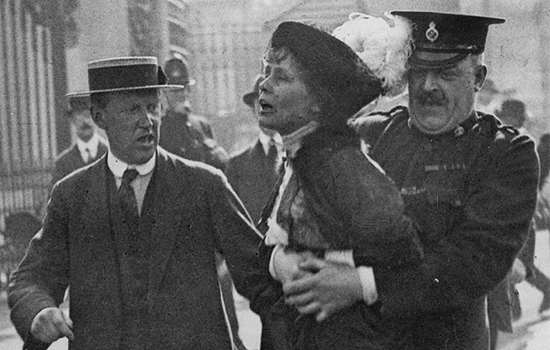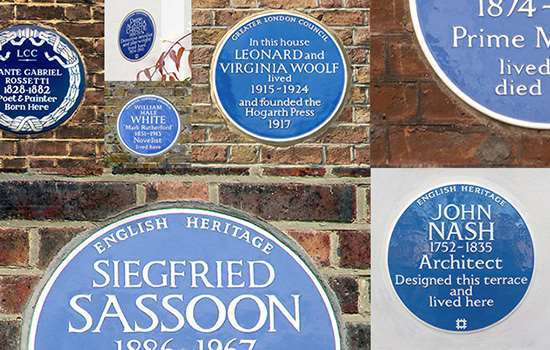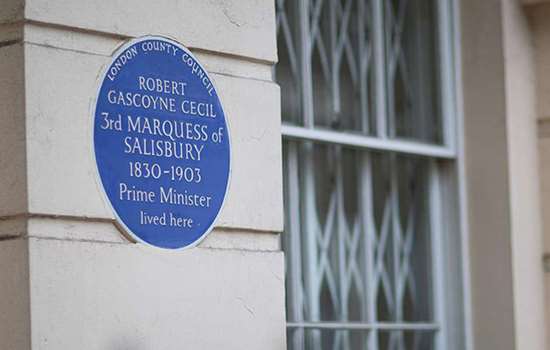CHURCHILL, Sir Winston, K.G. (1874-1965)
Plaque erected in 1985 by Greater London Council at 28 Hyde Park Gate, Kensington, London, SW7 5DJ, Royal Borough of Kensington and Chelsea
All images © English Heritage
Profession
Politician
Category
Politics and Administration
Inscription
SIR WINSTON CHURCHILL, K.G. 1874-1965 Prime Minister lived and died here
Material
Ceramic
Sir Winston Churchill, KG (1874–1965), the United Kingdom’s Prime Minister during the Second World War, has an official blue plaque on his post-war London home at 28 Hyde Park Gate.
From Gallipoli to Downing Street
Churchill served as a soldier in India and Sudan, and as a war correspondent during the Boer War. He first entered Parliament in 1900 as a Conservative, but joined the Liberals and served in the cabinet of Herbert Asquith. Following the defeat at Gallipoli, Turkey, in May 1915, which saw the loss of some 150,000 Allied soldiers, he resigned as First Lord of the Admiralty, though the disaster was by no means entirely his fault. Afterwards Churchill joined up and commanded a battalion on the Western Front, where he was nearly killed by a shell.
Churchill returned to the war cabinet in 1917; in all he held eight ministerial posts, culminating in his appointment as Chancellor of the Exchequer under Stanley Baldwin, having rejoined the Conservatives in 1924. From 1929 he was out of office, re-emerging in the late 1930s as an opponent of the policy of appeasement – which offered concessions to Hitler – and a supporter of re-armament.
Events proved Churchill right, and he replaced Neville Chamberlain in May 1940 as Prime Minister, becoming the first Prime Minister since the Duke of Wellington to have served in the field. At that critical time, he was the only candidate who could command sufficient cross-party support to form a broad national coalition. Beyond Westminster, his achievement was in uniting the country behind a solid conviction that the battle against the Nazis could be won.
As a war leader Churchill was known for his extraordinary energy and his inspirational speeches. Perhaps his most famous was delivered to the House of Commons on 4 June 1940, and included the lines:
We shall fight on the beaches, we shall fight on the landing grounds, we shall fight in the fields and in the streets, we shall fight in the hills; we shall never surrender.
Churchill’s success in securing the support of the United States – his mother was an American – was instrumental in the eventual Allied triumph. But he was disappointed in the junior role accorded to Britain in this relationship once the war ended. In November 1942 he stated that had not become Prime Minister ‘to preside over the liquidation of the British Empire’. By that point Singapore had fallen; the writing was on the wall.
Hyde Park Gate
After losing the general election of 1945, Churchill bought 28 Hyde Park Gate as a London base – his other home was Chartwell, in Kent – and straight away had it redecorated. One room was assigned as what he called his ‘snob library’ of beautifully bound books. The walls were hung with pictures of his aristocratic ancestors, who included the Duke of Marlborough, the victor of the Battle of Blenheim (1704). A portrait of Churchill himself, painted by Sir John Lavery, was also on show. Churchill bought number 27, next door, for £7,000 in 1946, originally for use as office accommodation. He later had the two houses combined; they were his longest standing London residence.
While out of office, Churchill wrote a six-volume account of the war, and turned his attention to the post-war world. In a speech delivered in Fulton, Missouri, in March 1946 he observed:
From Stettin, in the Baltic, to Trieste, in the Adriatic, an iron curtain has descended across the Continent.
The general election of 1951 saw Churchill return as Prime Minister, and to 10 Downing Street. He retired in 1955, aged 81, but remained the MP for Woodford until the year before he died.
In his semi-retirement, he returned to live at Hyde Park Gate. During this time Churchill travelled – he enjoyed several cruises – and lectured. He took up painting again and revised and completed his monumental History of the English-Speaking Peoples (1956–8). A crowd sang ‘Happy Birthday’ to him outside his London house on his 90th birthday, and Churchill replied with his familiar victory sign from a window. After suffering a series of strokes, he died at the address the following January.
Reputation
Churchill’s wartime premiership marks him as the outstanding British leader of the 20th century. His leadership was vital in defending democracy against fascism. The remarkable political comeback he made to lead the government – at the age of 65 – was founded on a gift for phrase-making and a strong sense of destiny.
His character had many facets. Unusually for a prominent man of his era, he cried easily and was frank about his episodes of depression: his ‘black dog’, as he called it. He was known for his fondness of cigars and for brandy, but was insistent that ‘I have taken more out of alcohol than alcohol has taken out of me’ – and neither habit prevented him living 90 years.
In his long career, some of Churchill’s actions were controversial. He authorised the use of military force against rioting strikers in Wales in 1910 and 1911, though without, it seems, the aggressive intent portrayed by some. In 1919 he deployed the notorious ‘Black and Tans’ – special constables – in an unsuccessful bid to quell the rising tide of rebellion in Ireland. The harsh economic conditions of the late 1920s have been linked to his insistence, as Chancellor, on a return to the gold standard.
Churchill’s wartime policy of saturation bombing of German cities such as Dresden has also been criticised (and defended), and he has been accused of inaction over the Bengal famine of 1943, in which millions died. He was hostile to anti-imperial movements, too – most notably that led by Gandhi in India.
Churchill’s role in the defeat of Nazism was undoubtedly his own ‘finest hour’. He also played a key part in shaping the post-war world in Britain and beyond. In 2002 he was voted number one in a poll to find the greatest Briton, though Churchill himself credited the nation with having ‘the lion’s heart. I had the luck to be called upon to give the roar.’
Further reading
Oxford Dictionary of National Biography (access via public library membership)
Nearby Blue Plaques
More About Blue Plaques



